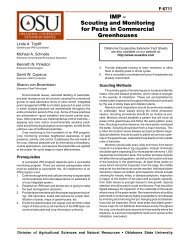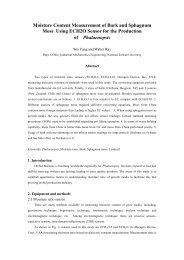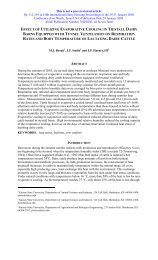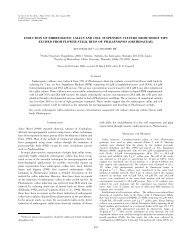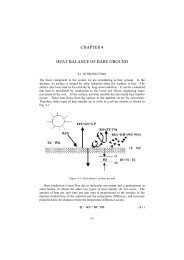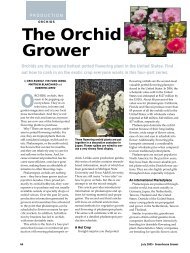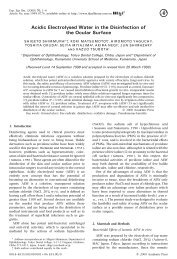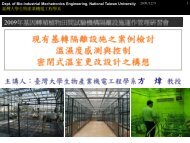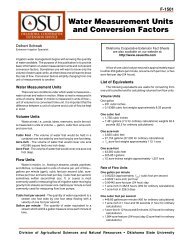266 B. Zalba et al. / Applied Thermal Engineering 23 (2003) 251–2833.1.2. Numerical soluti<strong>on</strong> c<strong>on</strong>sidering <strong>on</strong>ly c<strong>on</strong>ducti<strong>on</strong>Although the dominant heat transfer mechanisms are c<strong>on</strong>ducti<strong>on</strong> and natural c<strong>on</strong>vecti<strong>on</strong> inliquid <strong>phase</strong>, the earliest literature analyses heat transfer basically by c<strong>on</strong>sidering <strong>on</strong>e-dimensi<strong>on</strong>alc<strong>on</strong>ducti<strong>on</strong> in pure substances. The first studies were by Lame and Clapeyr<strong>on</strong> in 1831 and Stefanin 1891, c<strong>on</strong>cerning ice formati<strong>on</strong>. In 1912 the results of F. Neuman were published, establishingprecise soluti<strong>on</strong>s to more general <strong>phase</strong> <strong>change</strong> problems. In 1943, L<strong>on</strong>d<strong>on</strong> and Seban [98]analysed the process of ice formati<strong>on</strong> for different geometries (cylinder, sphere, and flat plate).This study is very interesting although it was later disputed by Shamsundar [99] who asserted thatL<strong>on</strong>d<strong>on</strong>Õs <strong>on</strong>e-dimensi<strong>on</strong>al formulati<strong>on</strong> led to errors increasing <strong>with</strong> the progress of the solidificati<strong>on</strong>process and proposed a two-dimensi<strong>on</strong>al formulati<strong>on</strong> for cylinders.In 1970, Lazaridis [100] put forward a study of the relative importance of c<strong>on</strong>ducti<strong>on</strong> andc<strong>on</strong>vecti<strong>on</strong>. Shamsundar and Sparrow [101] dem<strong>on</strong>strated the equivalence between the <strong>energy</strong>c<strong>on</strong>versati<strong>on</strong> equati<strong>on</strong> applied in the three z<strong>on</strong>es (solid, liquid, and solid/liquid) and the enthalpymodel. These are solved through a finite differential method and the solidificati<strong>on</strong> is analysed in asquare plate cooled by means of c<strong>on</strong>vecti<strong>on</strong>. This method is valid both for <strong>phase</strong> <strong>change</strong> in a singletemperature and for <strong>phase</strong> <strong>change</strong> in a range of temperatures (mixtures or alloys). Am<strong>on</strong>g thehypotheses in this work, it can be pointed out that the authors do not c<strong>on</strong>sider c<strong>on</strong>vecti<strong>on</strong> inthe melting <strong>phase</strong> and assume the solid and liquid densities to be equal and uniform. Later[102], they evaluated the effects of density <strong>change</strong>. In their c<strong>on</strong>clusi<strong>on</strong>s, the relati<strong>on</strong> between theheat transfer speed and the Biot number, linked <strong>with</strong> c<strong>on</strong>vecti<strong>on</strong> of the heat-carrier fluid, wasalready presented. Goodling [103] resolved a <strong>on</strong>e-dimensi<strong>on</strong>al geometry outward solidificati<strong>on</strong> ina cylinder <strong>with</strong> a c<strong>on</strong>stant heat flow in the inner wall, the soluti<strong>on</strong> being given by the finite differencemethod applied to the temperature.Meyer [104] studied the problem of <strong>phase</strong> <strong>change</strong> c<strong>on</strong>ducti<strong>on</strong>, establishing that the classicStefan problem implied the resoluti<strong>on</strong> of the temperature range and carrying out a review andcomparis<strong>on</strong> of explicit and implicit methods. The same year, Marshall published a work [105]studying natural c<strong>on</strong>vecti<strong>on</strong> effects in an annular geometry using hydrated salts and waxes/paraffins.He showed that the existence of natural c<strong>on</strong>vecti<strong>on</strong> significantly reduced the time necessaryfor melting, and gave recommendati<strong>on</strong>s for making use of natural c<strong>on</strong>vecti<strong>on</strong> especially <strong>with</strong>substances of low <strong>thermal</strong> c<strong>on</strong>ductivity (paraffins).Bathelt [106] worked <strong>with</strong> heptadecane (C 17 H 36 ) and studied solidificati<strong>on</strong> around a horiz<strong>on</strong>talcylinder. Using photographs, he showed the important role of natural c<strong>on</strong>vecti<strong>on</strong>, which increases<strong>with</strong> time and produces an increase in the average radius of solidificati<strong>on</strong> (n<strong>on</strong>-c<strong>on</strong>centric). Thistwo-dimensi<strong>on</strong>al behaviour for this geometry has also been c<strong>on</strong>firmed by other authors [30,107].Shamsundar and Srinivasan [108] analysed a heat ex<strong>change</strong>r of shell and tubes, and proposed atwo-dimensi<strong>on</strong>al analysis [99], also taking into c<strong>on</strong>siderati<strong>on</strong> the axial variati<strong>on</strong> of the temperature,thus approaching a three-dimensi<strong>on</strong>al analysis. In 1981 Sparrow [109] analysed solidificati<strong>on</strong><strong>on</strong> the outside of a tube carrying coolant inside, and c<strong>on</strong>firmed the influence of the axial temperaturevariati<strong>on</strong> of the coolant. He proposed an analytical soluti<strong>on</strong> providing initial values forthe numerical method in which the moving boundary is immobilized by a transformati<strong>on</strong> of coordinates.As a c<strong>on</strong>tinuati<strong>on</strong> of previous works, Shamsundar in 1981 [110] studied the influence of<strong>change</strong> in volume <strong>on</strong> <strong>phase</strong> <strong>change</strong> in the range of 10–20%. This involves the formati<strong>on</strong> of cavitiesin the top part through which it is supposed there is no heat transfer (an additi<strong>on</strong>al adiabaticwall), so the usefulness of the methodology is therefore justified although there is density <strong>change</strong>
B. Zalba et al. / Applied Thermal Engineering 23 (2003) 251–283 267in the solidificati<strong>on</strong>. The same author in 1982 [111] developed analytical soluti<strong>on</strong>s and evaluatedthe resulting formulati<strong>on</strong> using results obtained <strong>with</strong> numerical methods given in previous articles[109].In 1983 Achard et al. [112] carried out a <strong>thermal</strong> <strong>storage</strong> experimental study <strong>on</strong> a test bench,using an immersed tubular heat ex<strong>change</strong>r in the PCM, both <strong>with</strong> salt hydrates and <strong>with</strong> fattyacids. They also developed a theoretical study using the enthalpy method and solved by means offinite differences, disregarding the c<strong>on</strong>vecti<strong>on</strong> effect. In the c<strong>on</strong>clusi<strong>on</strong> the theoretical and experimentalresults were compared and significant discrepancies found in the melting. It was thereforededuced that it is necessary to c<strong>on</strong>sider natural c<strong>on</strong>vecti<strong>on</strong> in the liquid.Hunter in 1989 [113] and Amdjadi in 1990 [114] c<strong>on</strong>firmed that the enthalpy method is the mostsuitable for real substances provided that there is no alterati<strong>on</strong> to the numerical scheme in theboundary. Amdjadi added that if the material has hysteresis, it is necessary to rearrange or adjustthe method. In this later work the finite differences method is used <strong>with</strong> a variable time step,adjusting it at each moment according to the stage of the <strong>phase</strong> <strong>change</strong> process. In 1999, Banaszeket al. [115,116] studied experimentally and numerically solid–liquid <strong>phase</strong> <strong>change</strong> in a spiral TESunit.3.1.3. Numerical soluti<strong>on</strong> c<strong>on</strong>sidering also c<strong>on</strong>vecti<strong>on</strong>The first publicati<strong>on</strong>s that include the c<strong>on</strong>vecti<strong>on</strong> heat transfer mechanism are Sparrow et al.[117] and Bathelt et al. [118]. An interesting article about c<strong>on</strong>vecti<strong>on</strong> is by Gobin [119] whoseobjective is to determine the influence of natural c<strong>on</strong>vecti<strong>on</strong> <strong>on</strong> the melting process. To modelthese processes, some articles [120–122] include the influence of the c<strong>on</strong>vecti<strong>on</strong> c<strong>on</strong>sidering aneffective <strong>thermal</strong> c<strong>on</strong>ductivity:k e¼ cRa nk l€Ozisik [123] includes a classificati<strong>on</strong> of the various soluti<strong>on</strong> methods:1. Exact soluti<strong>on</strong>s, limited to a few idealised situati<strong>on</strong>s.2. Integral method. One-dimensi<strong>on</strong>al: soluti<strong>on</strong> of an integral equati<strong>on</strong> to localise the boundary[124].3. Heat moving source method.4. Perturbati<strong>on</strong> method [124].5. Electrical analogy (this is being replaced by numerical methods owing to the availability ofpowerful computers).6. Finite differences method.7. Finite elements method.Completing this classificati<strong>on</strong>, Ismail et al. [125] compare the results obtained <strong>with</strong> four differentnumerical methods, that is, the c<strong>on</strong>tinuous solid <strong>phase</strong> models, SchumannÕs model, thesingle <strong>phase</strong> models and the <strong>thermal</strong> diffusi<strong>on</strong> models or models <strong>with</strong> <strong>thermal</strong> gradient insidethe particles. The authors evaluate the models in relati<strong>on</strong> to the computati<strong>on</strong>al time c<strong>on</strong>sumedto solve a specific test problem and then compare them in relati<strong>on</strong> to the influence to differentfactors. Also Ismail et al. in another publicati<strong>on</strong> [126] divide the numerical methods for the



